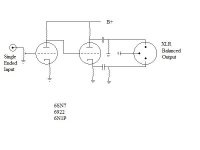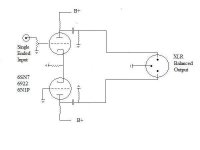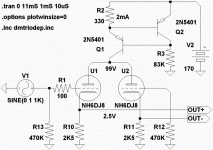Hey all you smart tube guys,
I have been getting real interested in Balance Connections to amps lately. I have a Pass Aleph 5, Krell Clone, that have balanced inputs, and eventually building a Aleph JX...
Anyway, I have been shorting the neg input to ground for single ended connections, but have been thinking of this idea to build a tube pre Concertina style to balanced XLR connections - see attachment.
Is there any reason this won't work? No values are set yet, just proof on concept only. Note - I do not have a balanced source.
Thinking a 6SN7, 6922 or 6N1P Input tube...
If a horribly dumb idea, go easy on me, as I am very thenthitive.
I have been getting real interested in Balance Connections to amps lately. I have a Pass Aleph 5, Krell Clone, that have balanced inputs, and eventually building a Aleph JX...
Anyway, I have been shorting the neg input to ground for single ended connections, but have been thinking of this idea to build a tube pre Concertina style to balanced XLR connections - see attachment.
Is there any reason this won't work? No values are set yet, just proof on concept only. Note - I do not have a balanced source.
Thinking a 6SN7, 6922 or 6N1P Input tube...
If a horribly dumb idea, go easy on me, as I am very thenthitive.
Attachments
Last edited:
Off the top of my head:
Sure it will work and as long as both outputs are equally loaded the concertina has approx 1/gm output impedance so it should behave... if equally loaded, which probably would be where I would have my doubts-cable impedance, input impedance etc need to be perfectly balanceed otherwise both signal balance and output impedance is compromised.
/Olof
Sure it will work and as long as both outputs are equally loaded the concertina has approx 1/gm output impedance so it should behave... if equally loaded, which probably would be where I would have my doubts-cable impedance, input impedance etc need to be perfectly balanceed otherwise both signal balance and output impedance is compromised.
/Olof
OK, so I haven't heard that it cannot, or should not, be done.
LTP version attached. Feel free to advise on additional components. Afterwards we can look at tubes and component values. I am leaning toward a 7N7 (loctal 6SN7)
Again, I have read that Balanced arrangement is a waste unless the entire chain is balanced (source/Pre/Amp).
Am I spinning my wheels since my source is single ended??
LTP version attached. Feel free to advise on additional components. Afterwards we can look at tubes and component values. I am leaning toward a 7N7 (loctal 6SN7)
Again, I have read that Balanced arrangement is a waste unless the entire chain is balanced (source/Pre/Amp).
Am I spinning my wheels since my source is single ended??
Attachments
Last edited:
Might need a topology with a lower output impedance to drive a cable + whatever is on the other end of that XLR cable, although with a short cable length and light input impedance it might work OK. If the load is heavy, you can cheat and feel good about it by buffering the outputs of the LTP using some MOSFET source followers 😀
XLR Cables will be made short (a foot), and should be feeding a few amps with input impedance of between 47k and 100k
Maybe an ICEpower ASP1000 (20k-ish?)
Am I correct in thinking the Concertina type would offer lower output impedance, but lower gain, while the LTP would offer higher gain and higher output impedance?
Maybe an ICEpower ASP1000 (20k-ish?)
Am I correct in thinking the Concertina type would offer lower output impedance, but lower gain, while the LTP would offer higher gain and higher output impedance?
Am I correct in thinking the Concertina type would offer lower output impedance, but lower gain, while the LTP would offer higher gain and higher output impedance?
You are correct, although driving a 47k load from the anodes of a 6SN7 in an LTP is really pushing it - a typical anode resistor for the 6SN7 is already somewhere in this order of magnitude, and if you go by the rule that the actual load resistance should be 10x that, then you will be way off!
The Concertina will probably drive the load just fine, but then each phase has a different output impedance (Very likely someone will correct me on this)
How about going the whole hog and using two 6SN7s, one as an LTP and another as two cathode followers (one for each phase) to provide a good strong drive?
For clarity here is a diagram (NOTE: Grid stoppers omitted)
You might want to float the heater supply on the cathode followers too, since the cathodes will be sitting at quite a high voltage, and a big heater to cathode differential is a Bad Thing
You might want to float the heater supply on the cathode followers too, since the cathodes will be sitting at quite a high voltage, and a big heater to cathode differential is a Bad Thing
Last edited:
The follower 6SN7s could be replaced with suitable MOSFETs too, if you want to save on tubes, which is understandable.
Since you have two triodes why not just a LTP. You get gain with that configuration.
Shoog
? You'll get more gain going common cathode + concertina than taking those same 2 triodes and making an LTP.
My solution of choice would also be the differential pair / long-tailed pair. However, note that the output impedance of the diff pair is fairly high so a source follower is recommended (needed if you need to drive any cable).
I've experimented with differential drive in solid state circuits and experienced an improvement in sound quality. Especially the link from the preamp to the power amp (located at the speakers) benefited from the differential link. The difference was subtle but in my opinion definitely worth the hassle.
~Tom
I've experimented with differential drive in solid state circuits and experienced an improvement in sound quality. Especially the link from the preamp to the power amp (located at the speakers) benefited from the differential link. The difference was subtle but in my opinion definitely worth the hassle.
~Tom
Greetings from FixitLand!
Correct! Pin 1 is ground; pin 2 is hot (i.e., in phase with the single-ended input); pin 3 is cold (antiphase of the single-ended input). The two earlier drawings showed pin 3 grounded. Most XLRs (Switchcraft products for sure) will have the pins numbered.
Take care,
--
J. E. Knox 'The Victor Freak'
Carefully with XLR: hot, cold, and ground pins. All your drawings contain the same errors.
Correct! Pin 1 is ground; pin 2 is hot (i.e., in phase with the single-ended input); pin 3 is cold (antiphase of the single-ended input). The two earlier drawings showed pin 3 grounded. Most XLRs (Switchcraft products for sure) will have the pins numbered.
Take care,
--
J. E. Knox 'The Victor Freak'
Carefully with XLR: hot, cold, and ground pins. All your drawings contain the same errors
Whoops, your right...I got the neg input and ground wrong.
Hmmm, like I said, I will be using short balanced cable around 1 - 1.5 feet.
I've experimented with differential drive in solid state circuits and experienced an improvement in sound quality. Especially the link from the preamp to the power amp (located at the speakers) benefited from the differential link. The difference was subtle but in my opinion definitely worth the hassle.
I have a bunch of 2SK170's and have been thinking of the same thing....
Last edited:
And of course: the nutty solution...
Hmmm.... I don't understand it Peter.
Wavebourn,
I actually have a pair of Sescom MI-14 600:600 transformers...this is preferred method of converting single ended to balanced?
What if you have a need for a preamp anyway? Build a conventional tube pre with single ended output and drop in the transformer?
I actually have a pair of Sescom MI-14 600:600 transformers...this is preferred method of converting single ended to balanced?
What if you have a need for a preamp anyway? Build a conventional tube pre with single ended output and drop in the transformer?
Post#16... Plate in, Cathode out... 1/(Mu-1) "The Fourth Circuit"Hmmm.... I don't understand it Peter.
Yet for this to work well, depends more upon quality of the CCS..
Less than unity voltage gain, but cathode impedances should be
low and fairly equal. Might be useful in balanced out application?
Strangely, DC levels are similar to a DAC... I don't know that to
be a useful feature or not? We would usually block DC to an XLR?
Except phantom power DC which is something else entirely, and
not needed in an output...
We sometimes too easily forget the plate impedance of a Triode
is low enough to abuse as an input. Occasionally might get some
love in a feedback loop. But rarely as seen here, a SE impedance
transformer.
Last edited:
Post#16... Plate in, Cathode out... 1/(Mu-1) "The Fourth Circuit"
Yet for this to work well, depends more upon quality of the CCS..
Less than unity voltage gain, but cathode impedances should be
low and fairly equal. Might be useful in balanced out application?
Strangely, DC levels are similar to a DAC... I don't know that to
be a useful feature or not? We would usually block DC to an XLR?
Except phantom power which is something else entirely....
We sometimes too easily forget the plate impedance of a Triode
is low enough to abuse as an input. Occasionally might get some
love in a feedback loop. But rarely as seen here, a SE impedance
transformer.
Thanks, I understand now. It is not a balanced out, but rather an out with distortion cancellation. But before canceling them we increase them powering anode from high-Z source. I still did not get the point.
Wavebourn,
I actually have a pair of Sescom MI-14 600:600 transformers...this is preferred method of converting single ended to balanced?
What if you have a need for a preamp anyway? Build a conventional tube pre with single ended output and drop in the transformer?
Yep. Say, if I use 10K:600Ohm transformer, I would build an amp with 10K output resistance. Power coupling for better S/N.
Edit: right now I paid for the kit:
Description: AUDIO TRANSFORMERS
Item #: PT-670
Unit price: $128.14
Qty: 1
Amount: $128.14
Subtotal: $128.14
Shipping and handling: $13.75
Total: $141.89 USD
The kit contains 8 transformers, exactly what I need to connect a pre-amp with a tube amp (stereo mic, guitar, keyboard) and a power transformer for preamp.
Last edited:
- Status
- Not open for further replies.
- Home
- Amplifiers
- Tubes / Valves
- Um, Can I do this?


